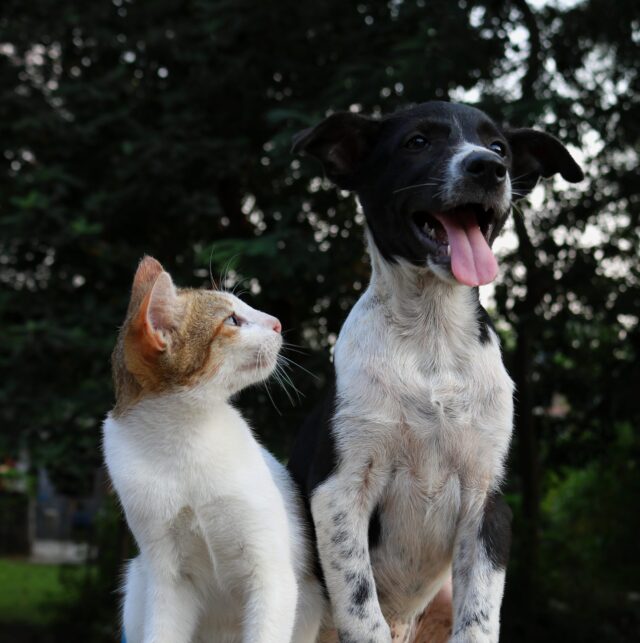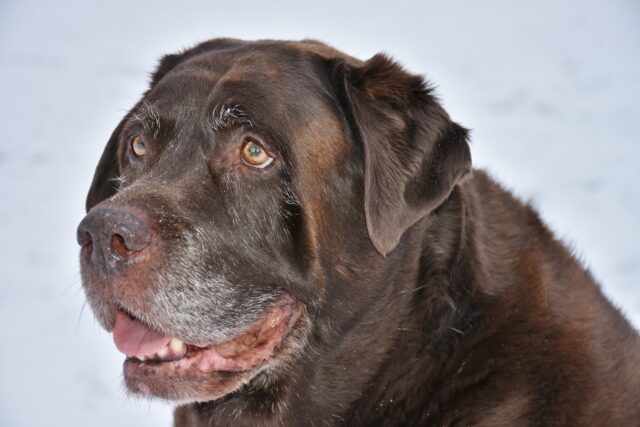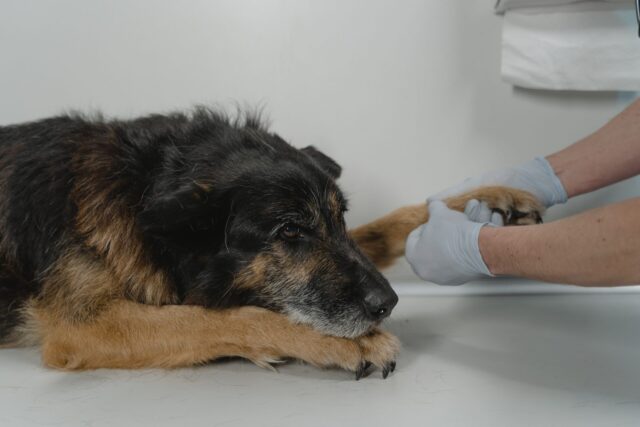Most people think dog years to human years is simple: multiply your dog’s age by seven. But modern research shows that this isn’t as effective as you’d think. Not all dogs fit into a cookie-cutter mold, especially dogs of different sizes. If you’ve been using the “times seven” approach for your dog’s age all these years, there’s now a better way to do it.
So, how old is your dog really? Are “dog years” even real? And how many dog years are in human years? Here’s an in-depth look at how to calculate your pet’s age as efficiently as possible.

What Are Dog Years to Human Years?
“Dog years” are real, but they’re not as cut-and-dried as we once thought. So, if the original dog years to human years rule is outdated, then what’s next? According to the American Kennel Club, the “seven-year” rule may have been a marketing strategy in its day. A way to remind pet parents that dogs don’t live nearly as long as we do. So, seeing the 7:1 ratio made visiting the vet yearly seem even more crucial.
The seven years idea shouldn’t be thrown out completely, though. It can still give you an idea of how old your dog is. But if you’re looking for an exact number for human years to dog years, you’ll have to dig deeper. Consider your dog’s size, breed, and health concerns for the best results. That will give you a more accurate answer for how many dog years to human years.
Average Dog Years to Human Years
Dogs don’t age at the same pace as humans. They age quickly in the first two years of their lives, and then their aging slows in their mature years. After all, they’re capable of giving birth in their first year, so the dog years should consider that. Yet, it’s important to note that certain dog breeds are known to live longer than others.

One way to discover your dog’s accurate age is to use a logarithm equation. The equation looks like this: (human_age = 16ln(dog_age) + 31). To find the answer, you need to plug in 16*ln(your dog’s age)+31 into your calculator. Most calculators should have the logarithm (ln) button.
But of course, not everyone is a math person. Some dog lovers prefer to know the reasoning behind these calculations. So, here is a break down of how to convert dog to human years:
- A dog’s first year is equal to about 15 human years.
- A dog’s second year is approximately nine human years.
- Every year after that equals around four to five human years.
With those things in mind, you should have a better idea of your dog’s age, even without knowing their size. But it’s common knowledge that small dogs live longer than large dogs. So, let’s take a closer look at your dog’s weight to better determine their age in human years. You can check the dog age chart for each size to determine how many dog years your pup has.

Dog Years to Human Years for Small Dogs
Small dogs are usually any dogs 20 pounds or less. They age at about the same pace as larger dogs at first, but then in their senior years, their aging slows down significantly.
Here is the human to dog years conversion for small dogs:
- 1 dog year = 15 years
- 2 dog years = 24 years
- 3 dog years = 28 years
- 4 dog years = 32 years
- 5 dog years = 36 years
- 6 dog years = 40 years
- 7 dog years = 44 years
- 8 dog years = 48 years
- 9 dog years = 52 years
- 10 dog years = 56 years
- 11 dog years = 60 years
- 12 dog years = 64 years
- 13 dog years = 68 years
- 14 dog years = 72 years
- 15 dog years = 76 years
- 16 dog years = 80 years
Most small dogs live between 10 and 14 years, but some can easily reach 15, 16, or even 17! Some common small breeds are Chihuahuas, Yorkshire Terriers, and Shih Tzus.

Dog Years to Human Years for Medium Dogs
Medium dogs fall between 21 and 50 pounds. They age similarly to small dogs, but at age 6, small dogs age slower than them. Of course, it’s common for medium dogs to still live a long, healthy life.
Here is the conversion for medium dogs:
- 1 dog year = 15 years
- 2 dog years = 24 years
- 3 dog years = 28 years
- 4 dog years = 32 years
- 5 dog years = 36 years
- 6 dog years = 42 years
- 7 dog years = 47 years
- 8 dog years = 51 years
- 9 dog years = 56 years
- 10 dog years = 60 years
- 11 dog years = 65 years
- 12 dog years = 69 years
- 13 dog years = 74 years
- 14 dog years = 78 years
- 15 dog years = 83 years
- 16 dog years = 87 years
Most medium dogs live between 10 and 13 years. Yet, that number might be more or less depending on the breed. Some medium-sized dog breeds include Pembroke Welsh Corgis, Staffordshire Bull Terriers, and Basenjis.

Dog Years to Human Years for Large Dogs
Large dogs are classified as any dog between 51 and 100 pounds. These dogs don’t live nearly as long as small dogs. So, they age faster than small and medium dogs when they reach age six. Then they continue to age faster from there.
Here is the conversion for large dogs:
- 1 dog year = 15 years
- 2 dog years = 24 years
- 3 dog years = 28 years
- 4 dog years = 32 years
- 5 dog years = 36 years
- 6 dog years = 45 years
- 7 dog years = 50 years
- 8 dog years = 55 years
- 9 dog years = 61 years
- 10 dog years = 66 years
- 11 dog years = 72 years
- 12 dog years = 77 years
- 13 dog years = 82 years
- 14 dog years = 88 years
- 15 dog years = 93 years
- 16 dog years = 99 years
Large dogs usually only live 8 to 12 years, depending on how big they are. Some large breeds include German Shepherds, Golden Retrievers, and Boxers.

Dog Years to Human Years for Giant Dogs
Finally, giant dogs are any dogs over 100 pounds. It’s less common to see dogs this large, but many dog parents have them. Giant dogs can be harder to care for and can be prone to more health concerns. They start by aging slower than smaller dogs. But then, by age three, they’re already aging faster than any dogs under 100 pounds.
Here is the conversion for giant dogs:
- 1 dog year = 12 years
- 2 dog years = 22 years
- 3 dog years = 31 years
- 4 dog years = 38 years
- 5 dog years = 45 years
- 6 dog years = 49 years
- 7 dog years = 56 years
- 8 dog years = 64 years
- 9 dog years = 71 years
- 10 dog years = 79 years
- 11 dog years = 86 years
- 12 dog years = 93 years
- 13 dog years = 100 years
- 14 dog years = 107 years
- 15 dog years = 114 years
- 16 dog years = 121 years
Giant breeds tend to only live 5 to 8 years, depending on the breed and care. Some common giant breeds are Great Danes, Irish Wolfhounds, and most Mastiffs.

How Do Dog Years Compare to Human Years?
So, what are dog years compared to human years? As you can see, dog years don’t easily match up with human years. It’s not always a 7:1 ratio like people expect. Instead, it starts out with 15 dog years to one human year, then nine years, then four or five, depending on the dog’s size. The average human lifespan is about 79 years, while the average dog lifespan is closer to 10 or 11. Thus, we can conclude that humans live about 7 times longer than dogs, which might be another reason the “seven-year” rule is so common.
What Are Cat Years to Human Years?
Now that you know how old your dog is in human years, you’re probably wondering if cat years transfer the same way. Since most cats weigh 10 pounds or less, they can all be grouped into the same category. And you can determine their human age like you would with a small dog. Yet, you can even break it down into their first months if needed.

Here are some things to keep in mind for cat ages:
- A cat’s first year is about the same as 15 human years.
- A cat’s second year is about the same as nine human years.
- Every year after that is the same as about four human years.
Here is the conversion for cats:
- 1 cat month = 1 year
- 3 cat months = 4 years
- 6 cat months = 10 years
- 12 cat months = 15 years
- 18 cat months = 21 years
- 2 cat years = 24 years
- 3 cat years = 28 years
- 4 cat years = 32 years
- 5 cat years = 36 years
- 6 cat years = 40 years
- 7 cat years = 44 years
- 8 cat years = 48 years
- 9 cat years = 52 years
- 10 cat years = 56 years
- 11 cat years = 60 years
- 12 cat years = 64 years
- 13 cat years = 68 years
- 14 cat years = 72 years
- 15 cat years = 76 years
- 16 cat years = 80 years
The average lifespan for a domesticated cat is 13 to 17 years. But they could live much shorter, especially if they spend a lot of time outside. Whether you have a Domestic Shorthair, Persian, or a Maine Coon, make sure you keep an eye on their health.

How Do You Know How Old Your Dog is?
If your pet is a rescue, it’s hard to know their exact age. That can make it even harder to calculate from human years to dog years or vice versa. But luckily, there’s a way you can estimate your pup’s age using the condition of their teeth. It’s a method that a lot of shelters and rescues use to make an educated guess. You can also consult a vet for a more accurate estimate.
According to WebMD, you can tell a dog’s age by looking at their teeth. If your dog had excellent dental care with their former family, then it might not be as accurate. But here’s a good rule of thumb to follow:
- 8 weeks old: Baby teeth are all in.
- 7 months old: Adult teeth are all in. They’ll look pure white and clean.
- 1-2 years old: Teeth might look duller. Back teeth could have a yellow tint.
- 3-5 years old: All the teeth have some wear and tartar buildup.
- 5-10 years old: The teeth have more wear and possibly signs of disease.
- 10 years and up: Teeth are worn with heavy tartar buildup. A few teeth could be missing.
These age estimates aren’t an exact science, but they can help you know what age range your dog falls in. Keep up with your dog’s dental care so their teeth will look as young and healthy as possible.
Determining a Precise Age
With most rescue dogs, it’s unlikely that you’ll ever be able to determine an exact birthday. However, the EpiPaws Pet Age Test Kit uses epigenetic sequencing technology to guess your dog’s age within a year of their actual age. (Get 10% off with the code IHDOGS10)
Signs of Aging in Dogs
Your vet can also guess your dog’s age based on the signs of aging they have, if any. They can conduct physical tests to see where your dog’s health stands. Tests could include physical exams of joints, bones, muscles, and internal organs. Yet, you might be able to spot some signs of aging on your own too.
Here are some common signs of aging in dogs:
- Gray hair, especially around the muzzle.
- Cloudy eyes or poor eyesight.
- Difficulty hearing.
- Loose skin.
- Stiff joints.
- Lower activity levels.
- Behavior changes, such as anxiety or accidents in the house.
Most dogs become seniors between 7 and 10 years old. The larger the dog, the sooner they’ll start showing signs of aging. For example, a Chihuahua could be 7 years old and still act like a puppy, while a Great Dane might’ve slowed down well before that. It varies from dog to dog, especially when it comes to size and breed.

It’s sad to see our dogs aging, which is why we should keep an eye on their health while we can. If you notice any of the above signs, your dog is probably in their senior years. You need to be extra gentle with senior dogs, and it’s important never to neglect vet appointments.
Why Do Smaller Dogs Live Longer Than Larger Dogs?
There has long been a mystery as to why smaller dogs live longer than big dogs. While this fact is true for dog lifespans, it doesn’t match up with science. In general, larger mammals are known to live longer than smaller ones. For example, a whale or an elephant will have a much longer life than a mouse. So, why is it the opposite for dogs?
The exact reason for this phenomenon is still unknown. But researchers believe that it has to do with how quickly larger dogs age. Larger dogs age at a faster rate than small dogs. It’s as if their lives are sped up. Larger dogs often have age-related health problems earlier in life, which is why their lifespans are often cut short. The growth spurts of large dogs could also lead to abnormal cell growth, making them more likely to develop cancer. And often, their joints deteriorate sooner due to the weight they have to support.
Scientists suggest that for every 4.4 pounds of body weight, a dog’s life expectancy is decreased by about a month. Some breeds normally weigh a lot, but many dogs are overweight. In fact, over half the dogs in the United States are overweight, affecting their lifespans. So, while it’s unclear why small dogs live the longest, it’s always important to keep your dog in shape as much as you can. Since small dogs live longer, that’s also why dog to human years vary based on a canine’s size.

How Can You Help Your Dog Live Longer?
Thinking about your dog’s age can be overwhelming, especially if they’re older than you thought. But luckily, you can help influence your dog’s lifespan. With proper care, you can help them live the long, fulfilling life they deserve.
Provide a Healthy Diet
Dog food is a big factor in a dog’s lifespan. Your dog’s food could be cutting their life short without you even realizing it. There are lots of myths about dog food, especially dry dog food. And many of those misconceptions are used to promote dog food sales. So, if your dog is overweight, gaining weight, or eating a lower-quality food, it might be time to consider a new diet.

Here are some things to note when choosing dog food:
- Choose a food that’s high in protein. Most dog food brands are packed with more carbs than protein because it’s cheaper and easier. But dogs don’t need any carbs in their diet at all. In most cases, they’re just unnecessary fillers.
- Meat as the first few ingredients is great, but not always accurate. Many of the best dog food brands list meat as the first two, three, or even four ingredients. But not all brands that brag about having meat as the first ingredient are trustworthy. Dog food ingredients are listed in order of weight before being cooked. Since meat is mostly moisture, it loses a lot of its weight in the manufacturing process. Thus, meat is often lower on the ingredient list than it seems.
- Watch out for questionable ingredients. Cheaper dog food brands will often sneak in some unsettling items, like by-products. Some will even put generic ingredient names, like “meat” or “poultry.” If you can’t tell exactly what’s going into your dog’s tummy, then you might want to choose a higher quality food.
- With food, less is usually more. Many dog parents have a bad habit of overfeeding their dogs. After all, it’s so hard to resist their cute faces! But obesity is a real concern for dogs of all ages, so consider serving smaller portions. Oftentimes, the serving suggestions on the bag are higher than you need them to be. It’s just another way for brands to get you to buy more food.
Partake in Daily Exercise
No matter how big or small your dog is, they need some daily exercise. For some dogs, a walk is enough to suffice. But for athletic dogs, hours of intense exercise might be necessary. It’s a good idea to understand a dog’s energy level before adopting them. Otherwise, you might bring home a dog that you can’t fully commit to. Walking, hiking, running, swimming, playing, advanced training, and completing agility courses are all great ways to exercise your pup.

Exercise not only helps keep your dog in shape, but it also helps lower stress and improve mood for the both of you. Even if you’re busy, stepping outside for a breath of fresh air and getting your blood pumping is a great way to help you feel more alive. In fact, research shows that walking your dog doesn’t only improve their well-being, but it improves human heart health too.
Don’t Forget Mental Stimulation
But physical exercise isn’t the only way to help your dog live a long life. Mental exercise is as important, especially for dogs that are working breeds. Mental stimulation includes tricks, puzzle toys, and anything else that can keep your dog’s mind busy. Bored dogs could grow anxious, depressed, or even sick over time. So, it’s never too late to find new ways to entertain your furry friend. Filling a toy with peanut butter or treats is a great way to relieve their boredom when you’re unable to play with them.
Spay or Neuter Your Dog
There are plenty of reasons to spay or neuter your dog, but health is an important one. Pets who are fixed have been known to live longer than those who are unaltered. The procedure makes them less susceptible to major health concerns, such as infections, cancer, and degenerative diseases. It also makes them less likely to run away, keeping them safe at home. Of course, even without considering this, it’s important to spay and neuter to help control the dog population. Too many dogs are dying in shelters, so we need to be responsible and stop unplanned puppies from entering this world.

Brush Your Dog’s Teeth
Teeth brushing is the most overlooked health aspect for dogs. Dog parents often forget to brush their dog’s teeth, but it takes a toll on dog lifespans. As it turns out, dog years and humans years aren’t as different as they seem because both need to brush their teeth daily to avoid major concerns. Even if you only brush your dog’s teeth once a week, you’re still extending their life. Dogs who don’t get their teeth cleaned enough could develop dental problems like plaque, gingivitis, and periodontal disease. Some dental diseases have even been linked to organ damage in dogs. So, even if it doesn’t lead to death, it will cause extreme pain and discomfort in your pup’s senior years.
If your dog loves to put up a fight for teeth brushing, there are plenty of alternatives to consider. Dental treats, toys, and rinses can make keeping your dog’s teeth clean even easier! Getting a deep clean from the vet can also help get their dental care back on track.
Bring Your Dog in for Annual Vet Check-ups
Even the healthiest dogs should see the vet. You never know when there might be an underlying illness in your dog that you don’t see. So, it’s recommended that you visit the vet at least once a year. For senior dogs, you might want to visit twice a year since they’re more prone to health concerns. Most dogs are considered seniors between 7 and 9 years old, but larger dogs age faster.

Vet appointments are perfect for keeping your dog up to date on their vaccinations. You can also request more of their monthly preventatives, including heartworm pills and flea and tick medication. All these things can add up quickly, but they’re the best way to keep your canine safe. If you suspect that something is wrong with your dog, don’t be afraid to contact your vet for advice.
Every Dog Year Counts
Converting dog years to human years might never be an exact science, but we know one thing for sure: every dog year counts. It can be helpful to know about how old our dogs are in human years, but that alone won’t extend their lifespans. Instead, it’s up to you to give them the best life possible. Dogs can’t live forever, but with proper care, we can help them live their lives to the fullest!

 Toledo, United States.
Toledo, United States.